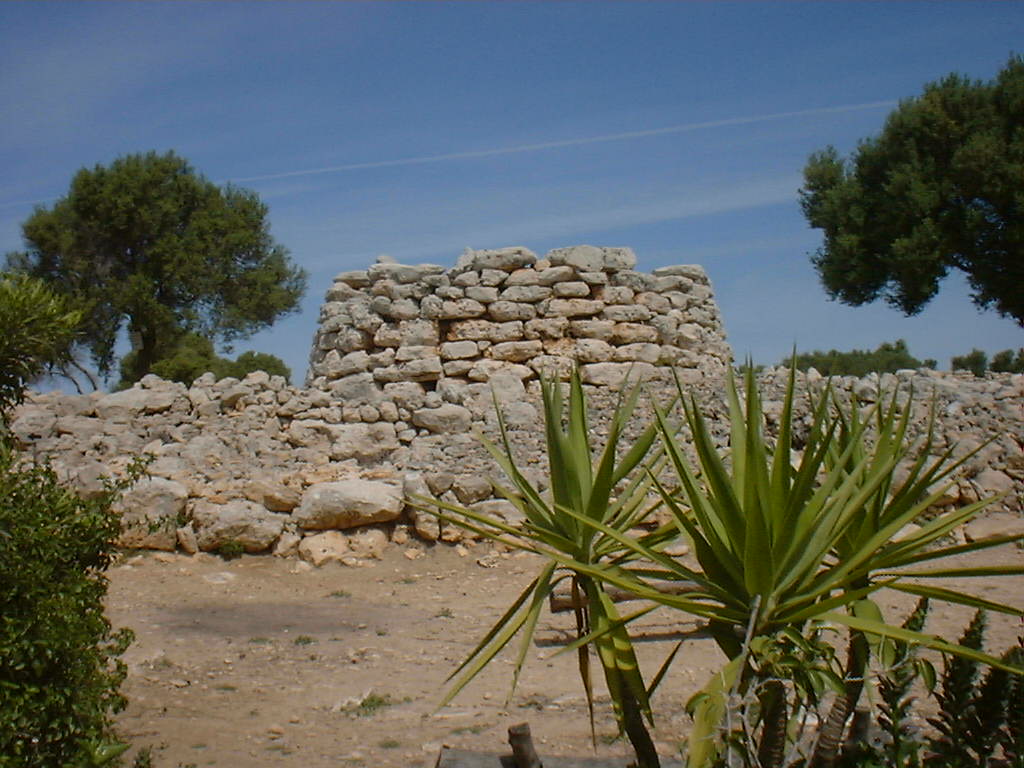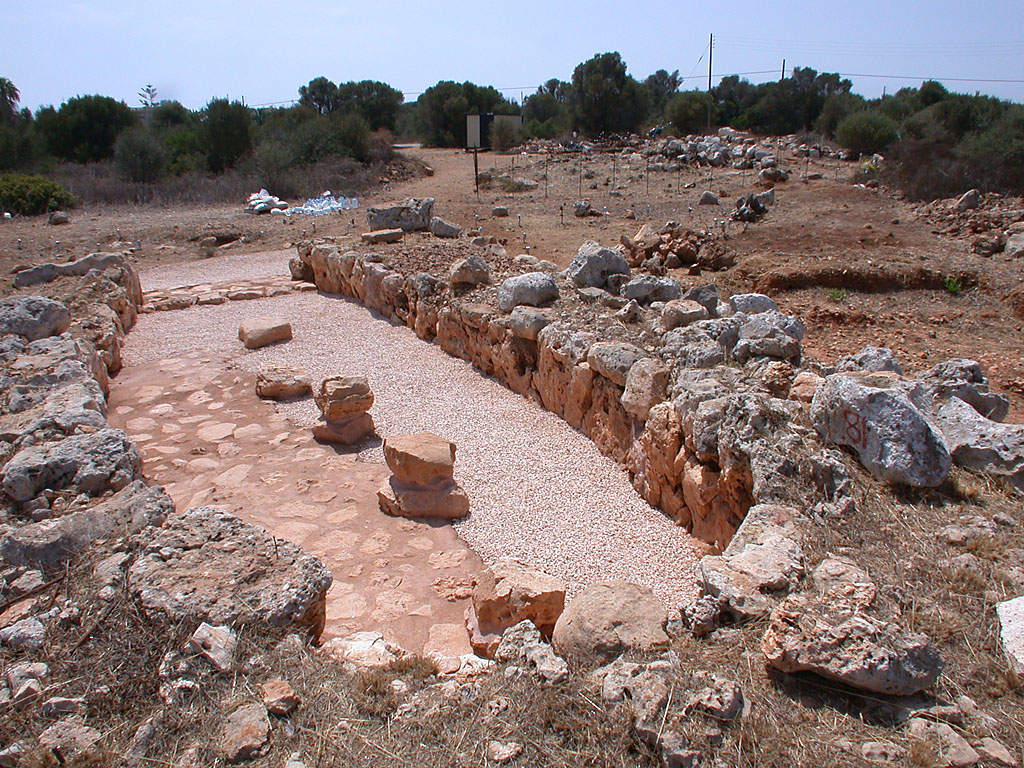|
Talaiot
A talaiot, or talayot (), is a Bronze Age megalith found on the islands of Menorca and Majorca forming part of the Talaiotic Culture or Talaiotic Period. Talaiots date back to the late second millennium and early first millennium BC. There are at least 274 of them, in, near, or related to Talaiotic settlements and the Talaiotic chamber tombs known as navetas. Talaiots pre-date the megalithic structures known as taulas, which are usually found nearby. While some Talaiots are thought to have had a defensive purpose, the use of others is not clearly understood. Some believe them to have served the purpose of lookout or signalling towers, as on Menorca, where they form a network. Talaiots generally take the form of circular or square buildings, and they may have been used as dwellings or meeting places. The talayots on Menorca have been much less prone to weathering than the ones found on Majorca. Despite this, very few grave goods have been found in Menorcan talayots, leading histor ... [...More Info...] [...Related Items...] OR: [Wikipedia] [Google] [Baidu] |
Talaiotic Culture
The Talaiotic culture or Talaiotic period is the name used to describe the society that existed on the Gymnesian Islands (the easternmost Balearic Islands) during the Iron Age. Its origins date from the end of the second millennium BC, when the inaccurately named Pre-Talaiotic Culture underwent a crisis and evolved into the Talaiotic Culture. Its name is derived from the Talaiot, talaiots, which are the most abundant and emblematic structures from the prehistoric period of the Balearic Islands. Origins Up until the end of the 20th century, it was theorized that the Talaiotic Culture arose out of interaction between new peoples from the eastern Mediterranean and local island culture, in the form of an aggressive invasion, or perhaps as a peaceful assimilation. The Talaiotic Culture arose at the same time that the crisis caused by the Sea Peoples was occurring, which had revolutionized societies in this part of the Mediterranean until the 13th century BC. These theories were b ... [...More Info...] [...Related Items...] OR: [Wikipedia] [Google] [Baidu] |
Talaiot
A talaiot, or talayot (), is a Bronze Age megalith found on the islands of Menorca and Majorca forming part of the Talaiotic Culture or Talaiotic Period. Talaiots date back to the late second millennium and early first millennium BC. There are at least 274 of them, in, near, or related to Talaiotic settlements and the Talaiotic chamber tombs known as navetas. Talaiots pre-date the megalithic structures known as taulas, which are usually found nearby. While some Talaiots are thought to have had a defensive purpose, the use of others is not clearly understood. Some believe them to have served the purpose of lookout or signalling towers, as on Menorca, where they form a network. Talaiots generally take the form of circular or square buildings, and they may have been used as dwellings or meeting places. The talayots on Menorca have been much less prone to weathering than the ones found on Majorca. Despite this, very few grave goods have been found in Menorcan talayots, leading histor ... [...More Info...] [...Related Items...] OR: [Wikipedia] [Google] [Baidu] |
Mallorca
Mallorca, or Majorca, is the largest of the Balearic Islands, which are part of Spain, and the List of islands in the Mediterranean#By area, seventh largest island in the Mediterranean Sea. The capital of the island, Palma, Majorca, Palma, is also the capital of the autonomous communities of Spain, autonomous community of the Balearic Islands. The Balearic Islands have been an autonomous region of Spain since 1983. There are two small islands off the coast of Mallorca: Cabrera, Balearic Islands, Cabrera (southeast of Palma) and Dragonera (west of Palma). The anthem of Mallorca is "La Balanguera". Like the other Balearic Islands of Menorca, Ibiza, and Formentera, the island is a highly popular holiday destination, particularly for tourists from the Netherlands, Republic of Ireland, Ireland, Germany, and the United Kingdom. The international airport, Palma de Mallorca Airport, is one of the busiest in Spain; it was used by 28 million passengers in 2017, with use increasing ever ... [...More Info...] [...Related Items...] OR: [Wikipedia] [Google] [Baidu] |
Megalith
A megalith is a large stone that has been used to construct a prehistoric structure or monument, either alone or together with other stones. More than 35,000 megalithic structures have been identified across Europe, ranging geographically from Sweden in the north to the Mediterranean Sea in the south. The word was first used in 1849 by the British antiquarian Algernon Herbert in reference to Stonehenge and derives from the Ancient Greek words " mega" for great and " lithos" for stone. Most extant megaliths were erected between the Neolithic period (although earlier Mesolithic examples are known) through the Chalcolithic period and into the Bronze Age. Types and definitions While "megalith" is often used to describe a single piece of stone, it also can be used to denote one or more rocks hewn in definite shapes for special purposes. It has been used to describe structures built by people from many parts of the world living in many different periods. The most widely known ... [...More Info...] [...Related Items...] OR: [Wikipedia] [Google] [Baidu] |
Torrean Civilization
The Torrean civilization was a Bronze Age megalithic civilization that developed in Southern Corsica, mostly concentrated south of Ajaccio, during the second half of the second millennium BC. History The characteristic buildings of this culture are the ''torri'' ("towers"), megalithic structures similar to the Sardinian nuraghes, from which the culture takes its name, and the ''castelli'' ("castles"), more complex buildings that include a wall, a tower and huts. According to preliminary investigations conducted during the 1950s by the French scholar Roger Grosjean, the Torrean civilization began when, at the end of the second millennium BC, the Sea People known as Sherden landed on the island from the Eastern Mediterranean, subduing the native megalithic population. The Sherden brought metallurgy to the island and built the ''torri'', which Grosjean thought were temples dedicated to the worship of fire and the dead. They also erected statue menhir representing their leader ... [...More Info...] [...Related Items...] OR: [Wikipedia] [Google] [Baidu] |
Naviforme
A naviforme (initially, navetiforme) was a prehistoric boat-shaped house built on the Balearic Islands of Spain. The hut-like buildings date to the Early Bronze Age or the Pretalayotic Period (ca. 2500–1200 B.C.). The building was generally large and had strong walls. It had dual functions for productive activities and living spaces. Examples of Naviformes are found in various villages but good examples have been excavated at Boquer, Sa Vall, and Son Mercer de Baix. The word naviforme originated from the building's resemblance to another prehistoric Menorcan structure, the naveta. Given the resemblance in their construction, the naviform was initially called a "navetiforme", a form of a "neveta", though, over time, the word was simplified to naviforme. When some are found together, it is difficult to distinguish between them, despite the naviforme being a home and the naveta being a tomb. Researchers believe that an extended family averaging 20 people could live in a naviforme. ... [...More Info...] [...Related Items...] OR: [Wikipedia] [Google] [Baidu] |
Taula
A taula (meaning 'table' in Catalan language, Catalan) is a Stonehenge-esque stone monument found on the Balearic Islands, Balearic island of Menorca. Taulas can be up to 5 metres high and consist of a vertical pillar (a monolith or several smaller stones on top of each other) with a horizontal stone lying on it. A U-shaped wall often encloses the structure. They were built by the Talaiotic culture between 500 BC and 300 BC. Their exact cultural meaning remains unknown, but they probably had religious and/or astronomical purposes. Most of the taulas face south, which seems to suggest some astronomical meaning. Archeologist Michael Hoskin has suggested the taulas may have been part of an ancient healing cult. They are frequently found near talaiots. The first author who wrote about these structures was Juan Ramis in his book ''Antigüedades célticas de la isla de Menorca'' ("Celtic Antiquities of the Island of Menorca"), which was published 1818, being the first book in the Sp ... [...More Info...] [...Related Items...] OR: [Wikipedia] [Google] [Baidu] |
Sardinia
Sardinia ( ; ; ) is the Mediterranean islands#By area, second-largest island in the Mediterranean Sea, after Sicily, and one of the Regions of Italy, twenty regions of Italy. It is located west of the Italian Peninsula, north of Tunisia and 16.45 km south of the French island of Corsica. It has over 1.5 million inhabitants as of 2025. It is one of the five Italian regions with some degree of Autonomous administrative division, domestic autonomy being granted by a Regions of Italy#Autonomous regions with special statute, special statute. Its official name, Autonomous Region of Sardinia, is bilingual in Italian language, Italian and Sardinian language, Sardinian: / . It is divided into four provinces of Italy, provinces and a Metropolitan cities of Italy, metropolitan city. Its capital (and largest city) is Cagliari. Sardinia's indigenous language and Algherese dialect, Algherese Catalan language, Catalan are referred to by both the regional and national law as two of ... [...More Info...] [...Related Items...] OR: [Wikipedia] [Google] [Baidu] |
Cement
A cement is a binder, a chemical substance used for construction that sets, hardens, and adheres to other materials to bind them together. Cement is seldom used on its own, but rather to bind sand and gravel ( aggregate) together. Cement mixed with fine aggregate produces mortar for masonry, or with sand and gravel, produces concrete. Concrete is the most widely used material in existence and is behind only water as the planet's most-consumed resource. Cements used in construction are usually inorganic, often lime- or calcium silicate-based, and are either hydraulic or less commonly non-hydraulic, depending on the ability of the cement to set in the presence of water (see hydraulic and non-hydraulic lime plaster). Hydraulic cements (e.g., Portland cement) set and become adhesive through a chemical reaction between the dry ingredients and water. The chemical reaction results in mineral hydrates that are not very water-soluble. This allows setting in wet conditions or u ... [...More Info...] [...Related Items...] OR: [Wikipedia] [Google] [Baidu] |





